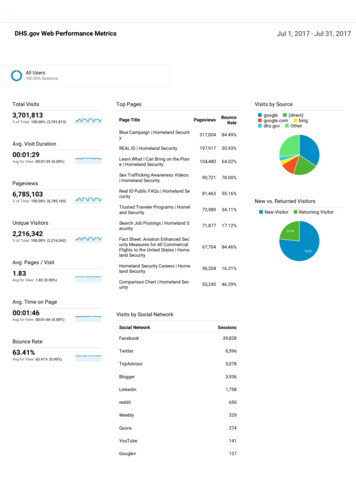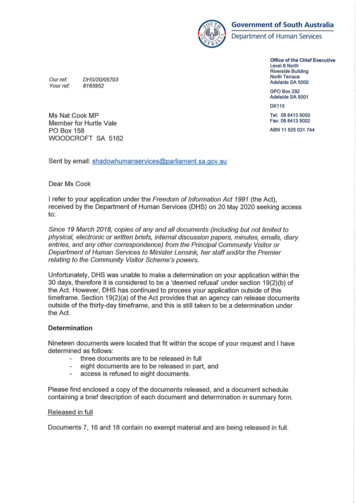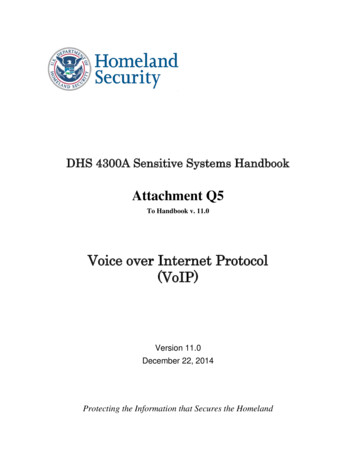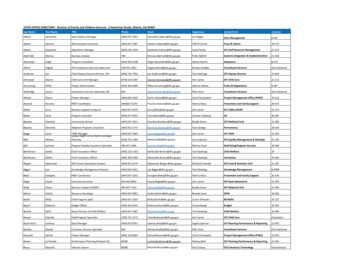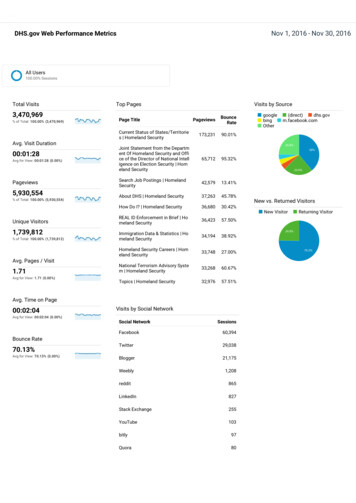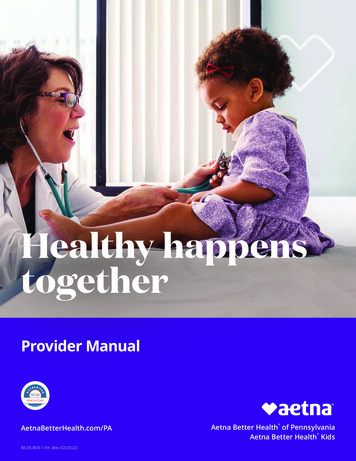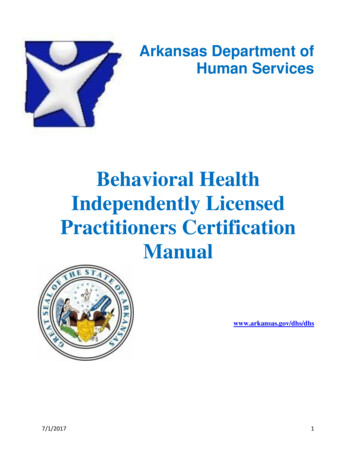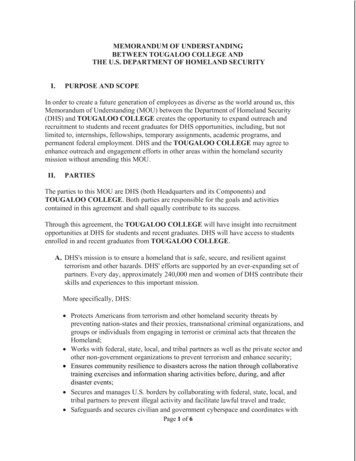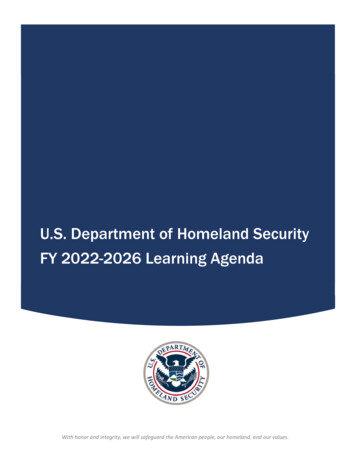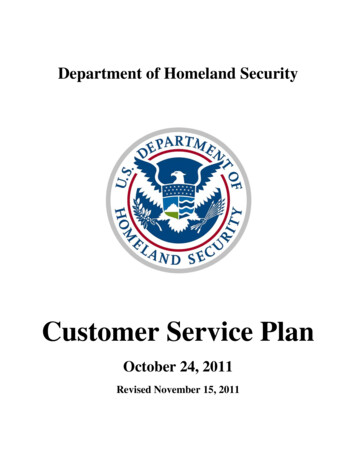
Transcription
Department of Homeland SecurityCustomer Service PlanOctober 24, 2011Revised November 15, 2011
Department of Homeland Security Customer Service Plan – 2011Executive SummaryThe Department of Homeland Security (DHS) has a vital mission: to lead efforts to achieve asafe, secure, and resilient homeland. This requires the dedication of more than 240,000employees in jobs that range from aviation and border security to emergency response, fromcybersecurity analysts to chemical facility inspectors. Our duties are wide-ranging, but our goalis clear - keeping America safe, secure, and resilient.To fulfill this mission, DHS employees interact with members of the public on a daily basis.DHS’s mission is diverse and consequently, so too are the customers that it serves. As requiredby Executive Order 13571, Streamlining Service Delivery and Improving Customer Service,DHS has developed this Customer Service Plan. The Plan’s purpose is to highlight effortscurrently underway that will improve DHS’s customer service, while strengthening security. Itdoes not include all of DHS’s efforts to improve customer service, but provides a sample of thetypes of initiatives that are being pursued across the Department. This includes: Using technology to focus on pre-screening of individuals who volunteer informationabout themselves prior to flying in order to expedite the traveling experience generally;Using mobile applications to disseminate information in times of a disaster; andCentralizing information and making it more easily accessible to non-citizens seeking tostudy in the United States and to the institutions that will host these individuals.Modernizing our enterprise public web capabilities to improve the customer experience,which we call our One-DHS web initiative.SIGNATURE INITIATIVE: RISK-BASED SECURITYOverview: The Transportation Security Administration (TSA) is undertaking efforts to enhance securityand focus its resources by applying new risk-based, intelligence driven security procedures andenhancing its use of technology, while also improving the passenger experience at security checkpoints.TSA is piloting several technology and process adjustments to enable expedited screening of knowntravelers. By using technology that helps identify passengers as low-risk and providing expeditedphysical screening, TSA can allocate personnel and technology resources towards unknown or high-riskpassenger screening while improving the passenger experience for the traveling public. During the pilot,certain frequent fliers and certain members of CBP's Trusted Traveler programs, including members ofGlobal Entry, SENTRI, and NEXUS, who are U.S. citizens, will be eligible to participate in this pilot, whichcould qualify them for expedited screening. All eligible frequent flyers and CBP Trusted Travelerparticipants must opt in to the program to be eligible for expedited screening. TSA continues toenhance its layered security approach through state-of-the-art technologies, expanded use of existingand proven technology, better passenger identification techniques and other developments that will2
Department of Homeland Security Customer Service Plan – 2011continue to strengthen aviation security. TSA will always incorporate random and unpredictable securitymeasures and no individual will be guaranteed expedited screening.Key Customer Groups: TSA’s intelligence-driven, risk-based approach to security will continue to focusresources to provide the most effective security in the most efficient way possible while improving thepassenger experience at security checkpoints. One component of risk-based security, TSA PreCheck,focuses on pre-screening individuals who volunteer information about themselves prior to flying inorder to potentially expedite the travel experience. Screening will be expedited for eligible passengerswho opt to participate and who are assessed by TSA as low-risk; in the initial pilot period, certainfrequent flyers and CBP Trusted Traveler participants are eligible.Challenges: For the initial pilot, select airlines with flights departing out of select cities are included.Also, since TSA will always incorporate random and unpredictable security measures, it must overcomemisperceptions that all eligible participants are guaranteed expedited screening.Featured Actions:1. Secure Flight technology enhancements--Secure Flight will expand its vetting capabilities toprescreen and vet passengers and apply intelligence-driven rules and random measures as partof its layered approach to security.2. Credential Authentication Technology/Boarding Pass Scanning System (CAT/BPSS)--CAT/BPSSscanners will allow TSA to automatically verify both passenger identification documents andboarding passes, further enhancing security. CAT/BPSS will help facilitate identity basedscreening, while making the checkpoint process more effective and efficient.SERVICE 1: SMART PHONE APPLICATIONS TO IMPROVE COMMUNICATION WITH PUBLIC DURING DISASTERRESPONSEFederal Emergency Management AgencyOverview: Information dissemination before, during and after a natural disaster or terrorist attack isvital to effective preparation and response. The Federal Emergency Management Agency (FEMA) hasbegun to leverage the technology of mobile devices to provide valuable information to the publicthrough a smartphone application (app). This application will provide information ranging fromemergency preparation checklists to search capabilities to the location of shelters within a 50-mileradius. The smartphone app was launched for Android devices on August 26, 2011 and there are effortscurrently underway to make the app available for iPhones and Blackberry version 6 devices. FEMArecognizes that not everyone has cell phones or smartphones, and continues to disseminate informationto all citizens through various communication mechanisms.Key Customer Groups: Any individual in the United States in need of preparedness and disasterresponse information.Challenges: One challenge is to increase public awareness and familiarity with the application.3
Department of Homeland Security Customer Service Plan – 2011SERVICE 2: ASSISTANCE TO INTERNATIONAL STUDENTS WANTING TO RECEIVE A DEGREE IN THE UNITED STATESDHS Office of Academic EngagementOverview: In September 2011, Department of Homeland Security Secretary Janet Napolitanoannounced the launch of the Study in the States initiative to streamline the international student visaprocess for foreign students seeking to study in the United States. This initiative will examine regulatoryand process changes, expand public engagement between the government and academia, and enhancecoordination between DHS components and partner agencies. It is meant to encourage and streamlinethe entry for legitimate non-immigrant students so that they can pursue educational and post-graduateopportunities in the U.S.A key component of the initiative is a new website, http://studyinthestates.dhs.gov, that establishes acentral online information hub for DHS and its agency partners to provide current and prospectiveinternational students with up-to-date information in a streamlined, dynamic, user-friendly format. Theinformation will help students understand the rules and regulations so they maintain legal status.International student offices and school officials’ information is also provided for students.In addition, we will be providing information about school certification – a critical process schools mustfollow in order to accept international students. Information on the Student and Exchange VisitorSystem (SEVIS) database and the roll-out of SEVIS II will be available for schools, including answers tohow this impacts them, what they need to do to prepare for the new system, etc.The Study in the States initiative uses technology and social media to improve customer service byproviding a central portal for all agencies involved in the international student process. The effortincludes: Interactive and accessible information, allowing prospective and current students to visuallynavigate steps of the student visa process on their own ‘Road Map to Success.’ Links to social media websites, such as Facebook and Twitter, relevant visa requirements andinformation to international students, exchange visitors, and the academic community. A blog with posted videos, public service announcements, relevant news, requirements, helpfultips and success stories.Key Customer Groups: Any individual seeking to pursue a degree in the United States.Challenges: There are more than 500,000 non-immigrant international students and exchange visitors inthe United States in a given year and over 35,000 officials at U.S. institutions that serve internationalstudents. Educating this vast and diverse group of customers about the U.S. Government requirementsis a challenge that this initiative will seek to address.4
Department of Homeland Security Customer Service Plan – 2011Key Milestones and TimelinePhase one of the website launched on September 16, 2011. Additional features will be included in thenext two scheduled phases. The additional phases will introduce the following features:Phase II (December 2011) Translate pages into 5 most common languages of international students Searchable database of schoolsPhase III (March 2012) Instant glossary of terms Roadmap to Success Instructional videosSERVICE 3: ONE-DHS WEB INITIATIVEMODERNIZING OUR ENTERPRISE PUBLIC WEB CAPABILITY TO BETTER SERVE CITIZENSDHS Headquarters Office of CIO and Office of Public AffairsOverview: Secretary Janet Napolitano’s December 2010 action directive on Web Systems Optimizationset DHS on a course for website consolidation to improve the customer experience without decreasingfunctionality. The web governance operation is informed by the Secretary's Action Directive on WebSystems Optimization. In that directive, her intent is to streamline customer access to DHS services,improve DHS web content management and reduce costs by establishing a strategy for web-contentmanagement and web-hosting services through consolidation and centralized hosting of DHS publicfacing websites.DHS has established the One DHS web initiative to improve customer experience and achieve efficiencygains for the enterprise public web.We will address three high-volume services for improvement:1. DHS public web consolidation, leveraging technology and innovation2. Search functionality3. Customer service standards for web and email/form channelsKey Customer Groups:Because our agency is very diverse, we have found it helpful to look at our audience from theperspective of how frequently they visit our public websites. For the headquarters site, our satisfactionsurvey asks the question: “Which best describes you? “ There were three possible responses thatcaptured a measure of visit frequency. For the period examined between April 1 and June 30, 20111,427 respondents replied. We found that:5
Department of Homeland Security Customer Service Plan – 2011 43 percent of the visitors were new or infrequent (satisfaction score: 67) 25 percent were occasional visitors (satisfaction score: 72) and 33 percent were frequent or “power” visitors (satisfaction score: 77)The number of clicks and site layout were their biggest concern. This research informs our choices tomake certain that we structure and deliver information that is optimized for everyday visitors, not justpower-users.Challenges:Our federal domain inventory shows we have 301 websites, including 63 top level domains, 150subdomains and microsites and 80 so-called “dot com” sites that are not on an approved domain, i.e.dot com or dot mil; additionally we also have 8 dot mil sites for the USCG. We have three types ofwebsites: content, applications and login sites. The large number of individual sites makes it difficult forvisitors to locate the authoritative content or find the most up-to-date information.Our approach to consolidation is taking shape in coordination with our Public Web Executive SteeringCommittee and our DHS Web Council as sites are reviewed. We have a dot gov roadmap for the toplevel domains and our planning for the dot com sites and the subdomains and microsites is underdevelopment.We must continue to mature our policy and procedures to achieve results, including developing andimplementing management directives and procedures for domain registration and record-keeping. Inaddition, we need to institute and implement a waiver process for our sites not on approved domains.A content cleanse to eliminate content that is redundant or out of date is necessary. The scope is large:we inventoried content by document type and found we have approximately 700,000 assets collectively.Pending a delegation of authority, we will implement Google Analytics to better understand our contentprior to major migration efforts so we do our work with an understanding of what content is mostpopular and visited and what content is suitable to be retired.Key Milestones and Timeline:Phase One: Governance and Discovery (complete in 2011) Web Council and Executive Steering Committee set up in 2011 Secretary’s data-call completed in early 2011 Google Analytics approved for use by Social Media Steering Committee Web Council Metrics Committee delivers customer standards for web and web forms/email6
Department of Homeland Security Customer Service Plan – 2011Phase Two: Technology Selection Pilot activityo Pilots with FEMA and USCIS to test two CMS platforms (begun in 2011)o Deployed Studyinthestates.dhs.gov and restorethegulf.gov in the public cloud Web Council Platform Committee to reporto Draft project plano Draft timeline Requirements on enterprise searcho Identify search pilotso USCIS.gov to pilot GSA Search service offeringPhase Three: Dot Gov Management Reforms Management Directive and procedures review and amendments Domain registration business process improvements Metrics enhancements and improvementso Web standards guide adopted, to include key performance indicatorso Monthly metrics dashboard established for Web Council and ESCo Roadmap for metrics tool adoptedPhase Four: Eliminate and duplication - content cleanse and consolidation Content cleanse to eliminate redundant and out of date information (Dependency: GoogleAnalytics delegation of authority)o Timeline and project plan recommendationso Requirements on content cleanse and level of effort analysis Taxonomy and Information Architectureo Use Google Analytics to establish priorities of users (Dependency: Google Analyticsdelegation of authority)o Use federal domain surveys to determine priorities of business owners Consolidation Roadmapo Deliver roadmap for top-level domains (2012 and 2013)o Implement waiver procedures for dot com sites and adjudicate those sites that are notprovided a waiver with a path to a dot gov URL or a consolidation plan into an existingsiteo Develop and execute plan of action for subdomains and microsite reviewPhase Five: Web content management and hosting services strategy approved by ESC (Dependency:our web improvement plan is subject to review by the Federal CIO and Dot Gov Task Force per OMB) Implementation and timeline managed by the Web ESCo Target completion for draft platform committee plan is the end of Quarter 2 FY127
Department of Homeland Security Customer Service Plan – 2011 URLs for top level and dot com sites will be scheduled to move to the new web-content andhosting-services platformo Subdomain and microsite schedule to be a follow-on activityo Plan for URLs not on schedule to move Component may seek a continuation waiver from DHS OPA If there is no waiver, sites will be decommissioned8
Department of Homeland Security Customer Service Plan – 2011SIGNATURE INITIATIVE: RISK-BASED SECURITYOverview: The Transportation Security Administration (TSA) is undertaking efforts to enhance securityand focus its resources by applying new risk-based, intelligence driven security procedures andenhancing its use of technology, while also improving the passenger experience at security checkpoints.TSA will pilot enhancements to Secure Flight prescreening technology that enables expedited screeningof known travelers. Through this program, TSA can focus on unknown or high-risk passenger screeningwhile improving the passenger experience for the traveling public. During the pilot certain frequentfliers and certain members of CBP's Trusted Traveler programs, including members of Global Entry,SENTRI, and NEXUS, who are U.S. citizens will be eligible to participate in this pilot, which could qualifythem for expedited screening. All eligible frequent flyers and CBP Trusted Traveler members must opt into the program to be eligible to participate. TSA continues to enhance its layered security approachthrough state-of-the-art technologies, expanded use of existing and proven technology, betterpassenger identification techniques and other developments that will continue to strengthen aviationsecurity. TSA will always incorporate random and unpredictable security measures throughout theairport and no individual will be guaranteed expedited screeningA. OverviewTSA’s intelligence-driven, risk-based approach to security will continue to focus resources to providethe most effective security in the most efficient way possible while improving the passengerexperience at security checkpoints.TSA is conducting pilots throughout FY 2012.During this pilot, TSA will use pre-screening capabilities to make intelligence-based risk assessments onpassengers who voluntarily participate in the program. Eligible participants include certain frequentflyers from Delta Air Lines and American Airlines as well as members of CBP’s Trusted Travelerprograms, including Global Entry, SENTRI, and NEXUS who are U.S. Citizens and are flying onparticipating airlines. Eligible passengers may be referred to a lane where they will experienceexpedited screening. TSA will always incorporate random and unpredictable security measuresthroughout the airport and no individual will be guaranteed expedited screening. TSA’s multi-layeredapproach to security also includes behavior detection officers, explosives-detection systems, canineteams, and federal air marshals, among other measures both seen and unseen.Additionally, TSA is modifying its screening procedures for passengers 12 and under to resolve alarms.Specifically, children are permitted to keep on shoes during screening and will be allowed multiplepasses through technology such as walk through metal detector in order to resolve alarms. Thesechanges in protocol will ultimately reduce – though not eliminate – pat-downs of children that wouldhave otherwise been conducted to resolve alarms. The purpose of this change is to minimize the impact9
Department of Homeland Security Customer Service Plan – 2011of screening measures on children while improving security by allowing TSA officers to better focus theirefforts on those who present a higher risk.After the initial pilots have been evaluated TSA will seek to expand these risk-based security protocols todrive efficiency for TSA and improve the passenger experience.B. Impact and BenefitsSecurity and operational gains will enhance security, engage external stakeholders to provide improvedcustomer service, and increase operational efficiencies.Specifically, risk-based security aims to use intelligence and technology to improve: Security Effectiveness–TSA’s first priority is to ensure that the implementation of RBS willimprove security across the system, based on the concept of pre-screening to separatepassengers by risk levels, and then focusing resources toward higher risk passengers. Passenger Satisfaction – TSA also seeks to improve overall satisfaction by providingopportunities for known travelers to undergo expedited screening. Operational Efficiency – TSA will increase productivity in the all checkpoint lanes byimplementing an expedited screening process for known passengers.C. Risk-Based Security Key Milestones and TimelineQ4 FY11 Complete Secure Flight technology enhancements and integration with CBP Global Entry toenable identification of low risk passengers through their boarding passes Implement new screening protocols for passengers 12 and underQ1 FY 12 Begin expedited screening pilot for known travelers with airline partners at four airports Award CAT/BPSS Low Rate of Initial Production UnitsQ2 FY 12 Expand expedited screening with an new airport partner and at an additional airportQ3 FY 12 Award CAT/BPSS full rate productionQ4 FY 12 Additional Secure Flight enhancements deployed to support the expansion of expeditedscreening10
Department of Homeland Security Customer Service Plan – 2011D. Increase Feedback from CustomersTSA will solicit feedback from both eligible known travelers and the flying public to inform customerengagement strategies. Feedback mechanisms TSA will pursue include: MyTSA Mobile App- The MyTSA Mobile App allows passengers to provide airport andcheckpoint specific feedback in real time as they travel. This functionality is currently availablethrough the TSA app and will be used to gather feedback for the pilot where expeditedscreening is available.Talk to TSA Kiosks- To gather targeted feedback from participants in the pilot, TSA is deployingself-service ‘Talk to TSA’ kiosks. Customers will be able to quickly and easily share directfeedback with TSA by answering questions as they exit the checkpoint. Kiosks will be deployedas the pilots begin in Q1 FY12.E. Adopt Best Practices for Improving Customer ExperienceTSA will focus on internal collaboration and technology as key enablers to improve the customerexperience. Best practices TSA will pursue include: One DHS- As part of the pilot, TSA will partner with CBP to build a Secure Flight interface andenable expedited screening for Global Entry members. By expanding the benefits provided toCBP GE members, DHS is improving service to a key customer segment. Integration with CBP forthe pilot will be complete in Q4 FY11. Risk-Based Security Engagement IPT- In Q2 FY11 TSA established an Integrated Project Team toproactively support risk-based security customer service across all communications channelsand stakeholder groups. By regularly convening TSA offices with distinct customer servicerequirements, TSA is able to proactively design engagement strategies, share lessons learned,and leverage communication materials. This integrated approach will ensure consistency,completeness and responsiveness of communications across diverse stakeholder groups. MyTSA Mobile App- The MyTSA Mobile App has informational pages and to assist specificpassenger segments (examples include: Military Personnel, families traveling with children, andthose with special medical needs).F. Set, Communicate, and Use Customer Service Metrics and StandardsTSA is committed to measuring and evaluating performance during the pilot implementation. Bypartnering with CBP and the airlines, TSA has developed communication strategies to drive participationduring the pilot period. Monitoring and Evaluating Key Performance Measures- Key performance measures for therisk-based security pilots are presented to the TSA Administrator, Deputy Administrator and11
Department of Homeland Security Customer Service Plan – 2011Senior Leadership Team on a weekly basis. By tracking key metrics like checkpoint throughput,contact center call volumes and comments, TSA leadership is able to fully evaluate the customerservice benefits of risk-based security. Increasing Access to Expedited Screening- During the pilot period, TSA will drive accessibility ofservice by partnering with airlines and CBP to provide detailed enrollment and opt ininformation. TSA will also pass out informational material with smartphone-readable QR codes , contact center information and CBP Global Entry enrollment information at the pilot airportsto ensure eligible passengers are able to receive expedited screening.G. Streamline Agency Processes to Reduce Costs and Accelerate DeliveryTSA will use technology to drive improvements in information access as well as drive efficiency. QR Codes - TSA will include two-dimensional codes readable by barcode readers onsmartphones on informational and promotional materials. When the code is scanned, it willautomatically direct passengers to a dedicated risk-based security site on the tsa.gov website.TSA will use QR Codes at all pilot airports to address inquiries at the time of travel. Targetedpages on tsa.gov support tailored information delivery with more flexibility and detail thanavailable on current signage. New signage and promotional materials with QR Codes will bedeployed to pilot airports in Q1 FY12.12
Department of Homeland Security Customer Service Plan – 2011SERVICE #1: SMART PHONE APP (APPLICATION) TO IMPROVE COMMUNICATION WITH PUBLIC DURING DISASTERRESPONSEFederal Emergency Management AgencyOverview: Information dissemination before, during and after a natural disaster or terrorist attack isvital to effective preparation and response. FEMA has begun to leverage the technology of mobiledevices to provide valuable information to the American public through a smartphone application (app).This application will provide information ranging from emergency preparation checklists to searchcapabilities to the location of shelters within a 50-mile radius. The smartphone app was launched forAndroid devices on August 26, and there are efforts currently underway to make the app available foriPhones and Blackberry version 6 devices. FEMA recognizes that not everyone has cell phones orsmartphones, and continues to disseminate information to all citizens through various communicationmechanisms. Version one of this capability has been deployed.1. Increase Feedback from Customers The purpose of this tool is to provide information to individuals in need of various types ofdisaster response. The public is able to provide feedback about the App through email and theFEMA blog.2. Adopt Best Practices for Improving Customer Experience The functionality of other smartphone apps and coding best practices has been helpful inshaping the development of the App.3. Set, Communicate, and Use Customer Service Metrics and Standards The application will allow users to access information helpful to disaster response, includingDisaster Recovery Centers and Shelters.4. Streamline Agency Processes to Reduce Costs and Accelerate Delivery Delivery of the FEMA app on a variety of smartphones will allow more users to access valuableinformation.13
Department of Homeland Security Customer Service Plan – 2011 The ability for users to access static information (ie., what to do after a disaster) without theavailability of WiFi or a wireless signal allows the public to be informed even if they don’t haveconnectivity. The availability of information through a smartphone app has the opportunity to minimize thenumber of inquiries during a disaster and to provide information in an expedited manner.14
Department of Homeland Security Customer Service Plan – 2011SERVICE #2: ASSISTANCE TO INTERNATIONAL STUDENTS WANTING TO RECEIVE A DEGREE IN THE UNITED STATESDHS Office of Academic EngagementOverview: In September 2011, Department of Homeland Security Secretary Janet Napolitanoannounced the launch of the Study in the States initiative streamline the international student visaprocess for foreign students seeking to study in the United States. This initiative will examine regulatoryand process changes, expand public engagement between the government and academia, and enhancecoordination between DHS components and partner agencies. It is meant to encourage and facilitatethe entry for legitimate non-immigrant students so that they can pursue educational and post-graduateopportunities in the U.S.A key component of the initiative is a new website, http://studyinthestates.dhs.gov, that establishes acentral online information hub for DHS and its agency partners to provide current and prospectiveinternational students with up-to-date information in a streamlined, dynamic, user-friendly format. Theinformation will help students understand the rules and regulations so they maintain legal status.International student offices and school officials’ information is also provided for students.In addition, we will be providing information about school certification – a critical process schools mustfollow in order to accept international students. Information on the Student and Exchange VisitorSystem (SEVIS) database and the roll-out of SEVIS II will be available for schools; including answers tohow this impacts them, what they need to do to prepare for the new system, etc.The Study in the States initiative uses technology and social media to improve customer service byproviding a central portal for all agencies involved in the international student process. The effortincludes: Interactive and accessible information, allowing prospective and current students to visuallynavigate steps of the student visa process on their own ‘Road Map to Success.’ Links to social media websites, such as Facebook and Twitter, relevant visa requirements andinformation to international students, exchange visitors, and the academic community. A blog with posted videos, public service announcements, relevant news, requirements, helpfultips and success stories.1. Increase Feedback from Customers “Ask a Question” and “Submit A Comment” features will be added in future phases of the sitedevelopmentSite analytics will be reviewed weekly to determine the most sought user information and thesite will be modified to best reflect user’s needs.15
Department of Homeland Security Customer Service Plan – 20112. Adopt Best Practices for Improving Customer Experience Coordinated, inter-agency cross-marketing campaigns will facilitate timely communication ofcritical infor
DHS has established the One DHS web initiative to improve customer experience and achieve efficiency gains for the enterprise public web. We will address three high -volume services for improvement: 1. DHS public web consolidation, leveraging technology and innovation 2. Search functionality 3.
